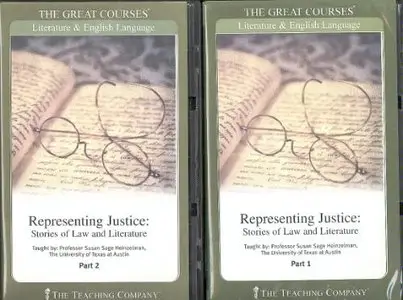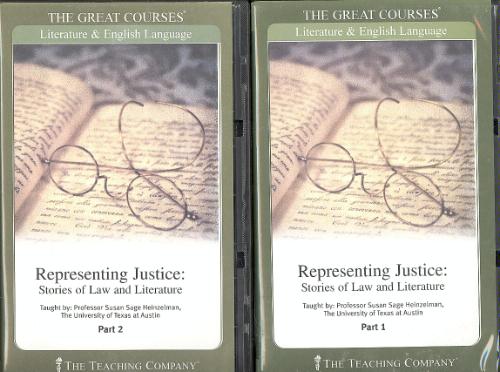"Representing Justice: Stories of Law and Literature" Parts 1 and 2 (The Great Courses)
Taught By Professor Susan Sage Heinzelman, Ph.D., University of Western Ontario, The University of Texas at Austin
Publisher: The Teaching Company (2006) | ISBN: 1598031406 | Language English | Audio CD in MP3 | 395 MB
Taught By Professor Susan Sage Heinzelman, Ph.D., University of Western Ontario, The University of Texas at Austin
Publisher: The Teaching Company (2006) | ISBN: 1598031406 | Language English | Audio CD in MP3 | 395 MB
This 24-lecture course offers a wide-ranging analysis of the relationship between law and literature by examining representative moments in the long history of these two interwoven ways of ordering the world, both representations of culture through language, image, symbol systems, and action.
Great literature can be the means of understanding as well as creating our world—by teaching and reinforcing society's laws, articulating its values, and enforcing the social contracts that unite us as a culture. What if literature itself generated our ideas and feelings about justice, marriage and family, property, authority, race, or gender? What if it enflamed our determination to pursue justice—or, conversely, undermined our ability to detect injustice?
What if law in all its variations—from religious commandments to oral tradition to codified statute—embraced its own narrative assumptions to the point of absorbing purely literary conventions as a means of more forcefully arguing its points in the legal arena?
And what if this dynamic relationship between written and unwritten laws and literature is constantly evolving? How do law and literature influence or reflect one other? And what lessons might we draw from their symbiotic relationship?
Representing Justice: Stories of Law and Literature is a provocative exploration of just such questions—an examination of the rhetorical and philosophical connections that link these two disciplines.
Mine the Riches of a New Scholarly Field
Professor Susan Sage Heinzelman, who has been honored many times for her teaching skills, is also president of the Association for the Study of Law, Culture, and the Humanities, and she brings to these lectures many years of thought and research into the roles of law and literature in society and culture and their relationship to one another.
She is especially concerned to break down the stereotypical definitions of these two disciplines: that literature is fictive and subjective, that is, persuasive on a primarily emotional level understood as the realm of the feminine, and that law is factual and objective, and thus primarily persuasive in the intellectual realm traditionally ascribed to the masculine.
Professor Heinzelman refers to the representation of culture, whether legal or literary, through language, image, symbol systems, and action. It is the intertwining of the stereotypical definitions that she untangles in these lectures, showing how each has contributed to creating our cultural beliefs and expectations "in similar ways—by offering us ways of imagining ourselves—both at our best and at our worst."
Professor Heinzelman's examination encompasses more than 3,000 years. It begins with the Old Testament—in which literature was law—and takes us through ancient Greece, the Middle Ages, England's experience of the Renaissance and the Enlightenment, and the 19th and 20th centuries. Focusing on works of literature that hold law, implicit or explicit, as a central theme—as well as on the overall relationship between law and literature in society—she shows how that relationship gradually transformed from the astoundingly intricate cross-connections between law and literature still present during the time of Shakespeare, to a point in the mid-18th century when the two disciplines separated more clearly into the distinct realms we recognize today.
Fresh Insights into Great Works and Their Eras
As Professor Heinzelman guides you through these great works, she shows how each reflects its times, and she offers fresh insights that can illuminate even those with which you may already be familiar. For example:
• In The Scarlet Letter , you'll see how a woman sentenced to a lifetime of community shame sets aside societal dictates to create a new standard of virtue for women.
• In the 1917 short story, A Jury of Her Peers, you'll see how a reporter covering a sensational turn-of-the-century murder trial would one day reconfigure the events of the case into a play and a short story that would dramatize the implications of all-male juries sitting in judgment on female defendants.
• And in Lolita, you'll see how a single literary work can challenge not only a society's written jurisprudence, but its unwritten moral codes, as well.
As presented by Professor Heinzelman, these and the other works explored in this course each present their own challenges, forcing you to re-evaluate the ways you read fiction, watch films and plays, or take in legal arguments. Indeed, you may never do any of these things the same way again.
About Your Professor
Susan Sage Heinzelman, Ph.D., is associate professor of English and Women's and Gender Studies at The University of Texas at Austin, where she has taught in both the English Department and the School of Law since receiving her doctorate from the University of Western Ontario in 1977. She specializes in 18th -century British literature; literary theory; and women, gender, and literature. The winner of many university teaching awards—most recently the President's Associates Teaching Award in 2003—Professor Heinzelman is also coeditor (with Zipporah Batshaw Wiseman) of Representing Women: Law, Literature, and Feminism (1994) and is the author of many articles on the representation of women in law and literature.
Course Lecture Titles
1. Literature as Law, Literature of Law
2. The Old Testament as Law and Literature
3. Revenge and Justice in Aeschylus’s Oresteia
4. Community in Sophocles’s Oedipus Tyrannus
5. Ritual Order in Mystery and Morality Plays
6. Chaucer’s Lawyers and Priests
7. Inns of Court, Royal Courts, and the Stage
8. Shakespeare’s Merchant of Venice (1596–97)
9. Shakespeare’s Measure for Measure (1603–04)
10. Shakespeare’s The Winter’s Tale (1609–11)
11. An Epic Trial—Milton’s Paradise Lost (1667)
12. Moll Flanders (1722); Beggar’s Opera (1727)
13. Trial Tales of Parricide Mary Blandy (1752)
14. Property and Self—Edgeworth, Burney, Austen
15. Law as Fog—Dickens’s Bleak House (1852–53)
16. Puritans Anew—The Scarlet Letter (1850)
17. Slavery and Huckleberry Finn (1885)
18. Victorian Limits—Tess and Jude the Obscure
19. Susan Glaspell’s “Jury of Her Peers” (1917)
20. Kafka and 20th-Century Anxiety about Law
21. Lolita (1958) and the Art of Confessing
22. “Witnessing” Slavery in Beloved (1987)
23. Maternal Infanticide—Myth and Judgment
24. Literature and Law—Past, Present, Future
Thanks to original uploader!







